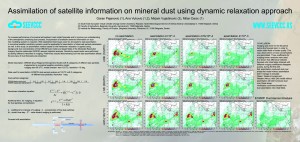DUST REGIONAL ATMOSPHERIC MODEL (DREAM)
Model description
DREAM model is developed as add-on component of an atmospheric model and is designed to simulate and/or predict the atmospheric cycle of mineral dust aerosol. It solves the Euler-type partial differential nonlinear equation for dust mass continuity. Dust concentration is one of the governing prognostic equations in an atmospheric numerical prediction model (Janjic, 1990, 1994, and references thereinafter).
DREAM simulates all major processes of the atmospheric dust cycle (Nickovic et al., 2001). During the model integration, calculation of the surface dust emission fluxes is made over the model cells declared as deserts. A viscous sub-layer parameterization regulates the amount of dust mass emission for a range of near-surface turbulent regimes. Once injected into the air, dust aerosol is driven by the atmospheric model variables: by turbulence in the early stage of the process when dust is lifted from the ground to the upper levels; by winds in the later phases of the process when dust travels away from the sources; and finally, by thermodynamic processes and rainfall of the atmospheric model and land cover features which provide wet and dry deposition of dust over the Earth surface.
In the dust emission scheme, aerosol injection into the atmosphere is controlled by type of soil, type of vegetation cover, soil moisture content, and surface atmospheric turbulence. USGS global 1-km land cover data is used to distinct the dust productive soils from the others. USDA global 1-km soil texture is used to describe particle size distribution. For each soil population (clay, silt, and sand) 8 particle size bins are calculated with effective radii of 0.15, 0.25 0.45, 0.78, 1.3, 2.2, 3.8 and 7.1 μm, respectively (Nickovic 2002). In order to include effects of dust aerosol to weather and climate, online interactive dust – radiation scheme has been developed (Nickovic 2002; Nickovic et al., 2003; Nickovic, 2004; Nickovic 2005; Perez et al., 2006).
Ongoing developments
Current SEEVCCC efforts are addressed to the following aerosol modelling research and development issues:
- Incorporating DREAM into the next-generation nonhydrostatic global/regional NCEP NMM-B model
- Dynamic assimilation of satellite aerosol optical depth data
- Dust and atmospheric ice nucleation
- Atmospheric transport of mineral fractions in dust; ocean fertilization; impact of mineral fractions on health
- Sea-salt atmospheric cycle
- Dust and aviation safety
DREAM is a successor of the single particle size dust model (Nickovic, 1996; Nickovic and Dobricic, 1996). With this model, first ever performed successful operational dust forecast was run during March-May 2005 in the Tunisian Meteorological Service. During 1996-1998, routine daily dust forecasts were available within the SKIRON project of the University of Athens. Further model developments continued in ICoD, University of Malta, and resulted in DREAM – the model with four particle bins and improved parameterizations for dust emission, deposition and advection; it was run daily during 1998-2005. An eight particle bin model version and interactive dust-radiation scheme were also developed. After 2005, operational DREAM dust forecasting system was transferred to the Barcelona Supercomputing Centre. DREAM is used in more than 15 organizations for operational and research purposes. SEEVCCC has recently incorporated DREAM into its integrated Earth modelling system, establishing operational forecasts and maintaining a continuous DREAM model development.
REFERENCES
Janjic Z. I. (1990), The step-mountain coordinate: Physical package, Mon. Weather Rev., 118, 1429– 1443.
Janjic Z. I. (1994), The Step-mountain Eta Coordinate Model: Further developments of the convection, viscous sublayer and turbulence closure schemes, Mon. Weather Rev., 122, 927– 945.
Nickovic S. (1996), Modelling of dust process for the Saharan and Mediterranean area. In: The impact of African dust across the Mediterranean, Eds: S. Guerzoni, and R. Chester, Kluwer Academic Publishers, Dordrecht., 15-23.
Nickovic S. and S. Dobricic (1996), A model for long-range transport of desert dust. Mon. Wea. Rew., 124, 2537-2544.
Nickovic S., A. Papadopoulos, O. Kakaliagou and G. Kallos (2001), Model for prediction of desert dust cycle in the atmosphere. J. Geophys. Res., 106, 18113-18129.
Nickovic S. (2002), Dust Aerosol Modeling: Step Toward Integrated Environmental Forecasting (Invited paper), Eos. Trans. AGU, 83(47), Fall Meet. Suppl., Abstract A71E-04.
Nickovic S., S. Music and A. Ansmann (2003), DREAM Dust Model: Ongoing and Future Developments. 2nd Workshop on Mineral Dust, Paris, 10-12 September 2003.
Nickovic S. (2004), Interactive Radiation-Dust Model: A Step to Further Improve Weather Forecasts (invited presentation). International Symposium on Sand and Dust Storm, Beijing, China, 12-14 September 2004.
Nickovic S. (2005), Distribution of dust mass over particle sizes: Impacts on atmospheric optics, paper presented at Fourth ADEC Workshop: Aeolian Dust Experiment on Climate Impact, Ministry of the Environ., Nagasaki, Japan.
Pérez C., S. Nickovic, G. Pejanovic, J. M. Baldasano and E. Ozsoy (2006), Interactive dust-radiation modeling: A step to improve weather forecasts, J. Geophys. Res., 111, D16206, doi:10.1029/2005JD006717.
Dust assimilation
New operational product is dust forecast with assimilation of ECMWF dust analysis in initial dust field.
To increase performance of numerical atmospheric dust model forecasts and to improve our understanding of the atmospheric underlying dust process, incorporation of available observed information on dust into modelling systems is required. Well established techniques used for atmospheric data assimilation in numerical weather prediction systems could be applicable for assimilation of observed aerosol parameters as well. Assimilation method is based on the Newtonian relaxation using background dust concentration of the DREAM dust model and target fields of ECMWF dust analysis that includes the Moderate Resolution Imaging Spectro-radiometer (MODIS) aerosol objective analysis.
Before releasing operational product several tests were done. Appliance of dust observation assimilation provided information about dust existence over areas where model didn’t manage to produce. Process of nudging starts at 6UTC, with coefficient of intensity of nudging 5×10-4, using previous model run results toward ECMWF dust analysis at 12UTC, and create initial dust field at 12UTC for new dust forecast.
In updated DREAM8assim forecast dust sources are defined using:
Ginoux, P., Chin, M., Tegen, I., Prospero, J., Holben, B., Dubovik, O., and Lin, S. J.: Sources and distributions of dust aerosols simulated with the GOCART model, J. Geophys. Res., 106(D17), 20255-20273, 2001.
Verification and improvement of the forecast using assimilation is presented at:
Pejanovic G., Nickovic S., Petkovic S., Vukovic A., Djurdjevic V., Vujadinovic M., Dacic M., 2012: “Dust operational forecast system with assimilation of dust analysed data”, Regional Conference on Dust and Dust Storms, Kuwait, 20-22 November 2012. Poster can be found here.







